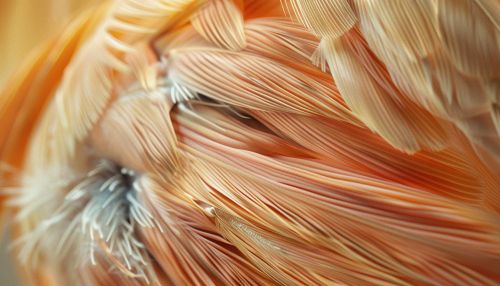Syringeal Muscles
Anatomy and Structure


The syringeal muscles are a group of specialized muscles located in the syrinx, the vocal organ of birds. Unlike the larynx in mammals, which is situated in the upper part of the airway, the syringeal muscles and the syrinx are located at the base of a bird's trachea where the trachea divides into the bronchi. This unique position allows birds to produce sound with both exhaling and inhaling air.
The syringeal muscles vary in number and complexity among different bird species, reflecting the diversity in bird vocalizations. The muscles can be intrinsic, attached within the syrinx, or extrinsic, attached from outside the syrinx. The intrinsic muscles are responsible for the fine control of sound production, while the extrinsic muscles control the larger movements of the syrinx.
Function and Mechanism
The syringeal muscles control the tension and position of the soft tissues and cartilages within the syrinx, thereby modulating the pitch, volume, and quality of the sound produced. When these muscles contract, they change the shape and tension of the syringeal walls, which in turn changes the frequency and amplitude of the vibrations. This mechanism of sound production is similar to how the vocal cords in mammals function.
In some bird species, the syringeal muscles can control each side of the syrinx independently, allowing these birds to produce two different sounds simultaneously, a phenomenon known as biphonation. This complex vocal ability is not found in any other group of animals.
Evolution and Diversity
The evolution of the syringeal muscles and the syrinx is closely tied to the evolution of bird song. The syrinx is a unique organ that evolved only in birds, and its complexity varies greatly among different bird species. Species with more complex songs typically have more complex syringeal muscles, suggesting a co-evolution of vocal complexity and syringeal muscle complexity.
The syringeal muscles in songbirds, for example, are highly specialized and complex, reflecting the intricate songs these birds produce. In contrast, birds that do not vocalize extensively, such as storks and vultures, have a simpler syringeal muscle structure.
Research and Studies
The study of syringeal muscles has provided insights into various aspects of bird biology, including vocal learning, sexual selection, and speciation. Research on these muscles has also contributed to our understanding of neuromuscular control and biomechanics.
Recent advances in imaging technologies, such as MRI, have allowed scientists to study the structure and function of the syringeal muscles in unprecedented detail. These studies have revealed the intricate coordination of various muscles during bird song production, shedding light on the neural control of complex motor behaviors.
